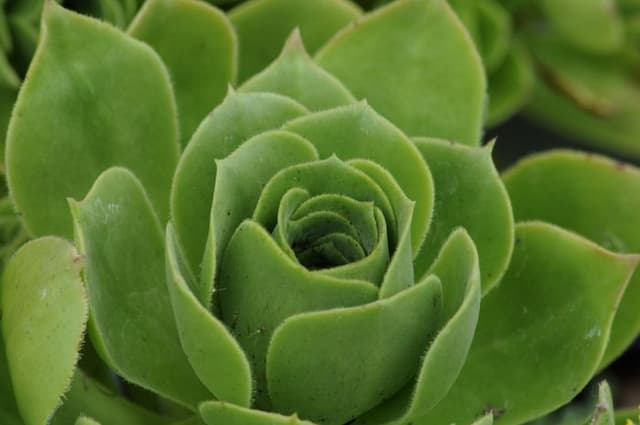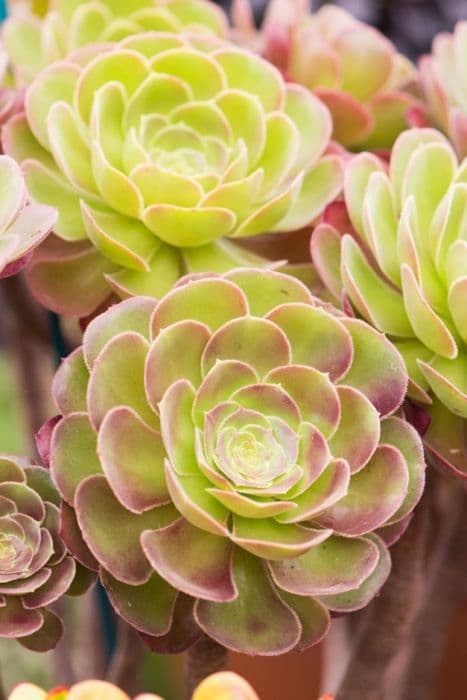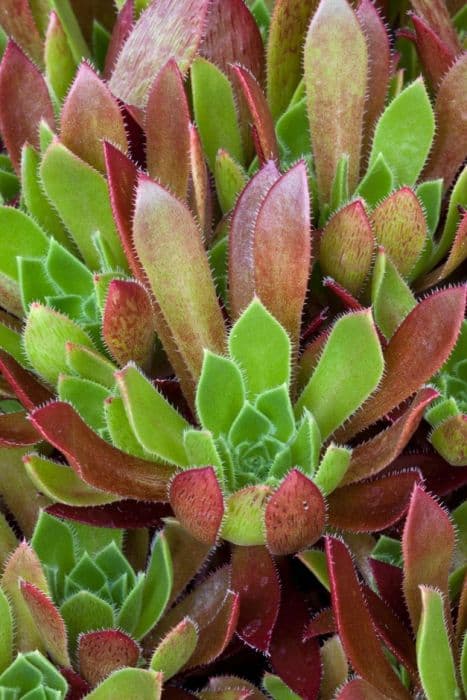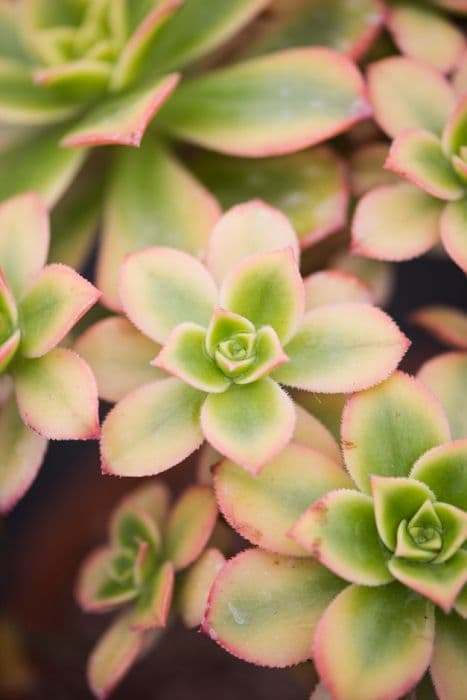Orpine Hylotelephium telephium 'Yellow Xenox' (PBR)

ABOUT
The 'Yellow Xenox' is a striking variety known for its distinctive foliage and flowers. The leaves of this plant are a unique shade of yellow, which adds a bright splash of color to any garden. As the growing season progresses, the foliage often deepens to rich tones of yellowish-orange, providing a warm contrast with its surroundings. The plant blooms in late summer to early autumn, producing clusters of star-shaped flowers that are an attractive pink to red color. These flowers are tightly packed together in prominent, rounded flower heads that sit atop the sturdy stems, giving off a vibrant and lively appearance. The blooms are highly appealing to bees, butterflies, and other pollinators, adding to the dynamic nature of the garden. The 'Yellow Xenox' is celebrated for its hardiness and its ability to withstand a range of growing conditions while still maintaining its vivid coloration and structural form. Its foliage and blooms together create a visual spectacle that adds interest and texture to the landscape.
About this plant
 Names
NamesFamily
Crassulaceae
Synonyms
Orpine, Livelong, Frog's-stomach, Harping Johnny, Life-everlasting, Live-forever, Midsummer-men, Orphan John, Witch's Moneybags
Common names
Sedum telephium 'Yellow Xenox'.
 Toxicity
ToxicityTo humans
Sedum telephium, commonly known as Orpine, has no widely reported toxicity to humans. If ingested in significant quantities, it may potentially cause mild gastrointestinal discomfort, but general exposure or casual contact with the plant is not known to cause harm.
To pets
Sedum telephium, commonly known as Orpine, is not considered toxic to pets such as dogs and cats. There are no widely known symptoms of poisoning from this plant. Generally, ingesting small amounts should not cause any ill effects, but consumption in large quantities may potentially lead to mild gastrointestinal upset in some pets.
 Characteristics
CharacteristicsLife cycle
Perennials
Foliage type
Deciduous
Color of leaves
Mixed
Flower color
Pink
Height
1-2 feet (30-60 cm)
Spread
1-2 feet (30-60 cm)
Plant type
Succulent
Hardiness zones
3
Native area
Europe
Benefits
 General Benefits
General Benefits- Easy to Care For: Sedum ‘Yellow Xenox’ is a low-maintenance plant that requires minimal attention once established, making it ideal for busy gardeners.
- Drought Tolerant: This sedum variety is highly drought-resistant, perfect for xeriscaping or regions with low rainfall.
- Attracts Pollinators: The flowers of Sedum ‘Yellow Xenox’ attract bees, butterflies, and other beneficial insects to the garden.
- Long Blooming: With a lengthy flowering period from late summer into fall, this plant provides extended interest in the landscape.
- Winter Interest: The dried flower heads can remain on the plant through winter, adding texture and interest to the garden in the colder months.
- Versatile: It’s suitable for various landscape uses, including borders, rock gardens, and containers.
- Foliage Interest: This plant offers attractive foliage with a unique color that can complement many garden designs.
- Deer and Rabbit Resistant: Sedum ‘Yellow Xenox’ is not favored by deer or rabbits, which can help reduce plant damage in the garden.
- Improves Soil Health: As a perennial, it can help with soil structure and health by reducing erosion and requiring less cultivation than annual plantings.
 Medical Properties
Medical PropertiesThis plant is not used for medical purposes.
 Air-purifying Qualities
Air-purifying QualitiesThis plant is not specifically known for air purifying qualities.
 Other Uses
Other Uses```html
- Educational purposes: Hylotelephium telephium, commonly known as Stonecrop, can be used in educational programs and botanical studies to teach about drought-resistant plants and succulent biology.
- Artistic inspiration: The unique color and structure of Stonecrop can inspire artists and be used as a subject in painting, photography, or sculpture.
- Green roofing: Stonecrop varieties are suitable for green roofs due to their resilience, low maintenance, and ability to thrive in shallow soil.
- Fauna habitat: Stonecrop can provide a microhabitat for insects and small animals, as well as a food source for pollinators like bees and butterflies.
- Erosion control: The dense growth habit of Stonecrop can help stabilize soil and prevent erosion on slopes or in rock gardens.
- Floral arrangements: Fresh or dried Stonecrop flowers can be used in bouquets and floral decor for their interesting textures and shapes.
- Cooking garnish: Although not commonly consumed, the edible leaves of some Stonecrop species can be used as a decorative garnish for culinary dishes.
- Photovoltaic system camouflage: Low-growing Stonecrop can be planted around ground-mounted solar panels to help them blend into a natural setting.
- Ground cover: In large garden spaces, Stonecrop can serve as a low-maintenance ground cover that requires minimal watering once established.
- Labyrinth gardens: Stonecrop can be used in the design of labyrinth gardens to outline pathways and create a meditative space.
Interesting Facts
 Feng Shui
Feng ShuiThe Stonecrop is not used in Feng Shui practice.
 Zodiac Sign Compitability
Zodiac Sign CompitabilityThe Stonecrop is not used in astrology practice.
 Plant Symbolism
Plant Symbolism- Resilience: Often associated with Stonecrop, which is one of its common names, Hylotelephium telephium 'Yellow Xenox' symbolizes the plant's ability to withstand harsh conditions and symbolizes the human trait of endurance.
- Timelessness: As a perennial with long-lasting foliage and blooms, Stonecrop represents ever-lasting or eternal elements, bridging past, present, and future.
- Adaptability: Stonecrop is known for its adaptable nature, thriving in a variety of soil types and climates. It reflects the ability to thrive in various conditions and environments.
 Water
WaterFor the 'Yellow Xenox' Stonecrop, a drought-tolerant perennial, water sparingly. Allow the soil to dry out completely between waterings, which might mean watering every 7 to 10 days during its active growth in spring and summer, depending on climate conditions. Cut back on watering in the fall and winter to monthly or even less, only to prevent the soil from becoming bone dry. When you do water, give the plant a thorough soaking, using around 0.5 gallons per square foot of soil area. This deep watering method encourages deeper root growth and improves the plant's drought resistance.
 Light
Light'Yellow Xenox' Stonecrop thrives in full sunlight and should be placed in a location where it receives at least 6 hours of direct sun per day. The ideal spot for this plant is in an area that gets bright, unfiltered sunlight throughout the day. The high light levels bring out the best in the foliage color and ensure a healthy, vigorous plant that blooms profusely.
 Temperature
TemperatureThe 'Yellow Xenox' Stonecrop is quite cold-hardy and can survive in temperatures as low as -30°F, making it suitable for many temperate climates. It performs best in an average temperature range between 65°F and 75°F. However, it's important to protect the plant from extreme heat; consistent temperatures over 85°F can stress the plant.
 Pruning
PruningPrune 'Yellow Xenox' Stonecrop to remove spent flower heads and encourage a second bloom, and to maintain plant shape and health. Ideally, pruning should be done shortly after the plant flowers, which is typically in late summer or early fall. Periodic deadheading during the blooming season can also promote more blooms and extend the flowering period.
 Cleaning
CleaningAs needed
 Soil
SoilAutumn Joy Sedum (the common name of Hylotelephium telephium 'Yellow Xenox' (PBR)) thrives in well-draining soil with a pH ranging from 6.0 to 7.5. The ideal soil mix consists of one part garden soil, one part peat, and one part perlite or coarse sand to ensure good drainage while retaining adequate moisture.
 Repotting
RepottingAutumn Joy Sedum should be repotted every 2-3 years or when it outgrows its current pot, which can be indicated by roots protruding from the drainage holes. When repotting, choose a pot only one size larger to prevent overwatering.
 Humidity & Misting
Humidity & MistingAutumn Joy Sedum prefers a low to average humidity level, consistent with typical household conditions. It is very tolerant of dry air and does not require high humidity to thrive. Avoid creating a humid environment as it can lead to rot or fungal diseases.
 Suitable locations
Suitable locationsIndoor
Place in bright light, minimal water.
Outdoor
Full sun, well-drained soil, cold hardy.
Hardiness zone
3-9 USDA
 Life cycle
Life cycleHylotelephium telephium 'Yellow Xenox' (PBR), commonly known as Stonecrop, begins its life cycle as a seed, which requires well-draining soil and exposure to the last frosts of spring to germinate effectively. Upon germination, the seedling emerges and develops into a juvenile plant with succulent leaves capable of storing water, which is crucial for surviving in its preferred sunny and dry conditions. As it matures, the Stonecrop enters the vegetative stage, expanding its fleshy foliage and branching out, while also establishing a robust root system. The adult phase is marked by the emergence of its distinct yellow flower clusters atop sturdy, upright stems in late summer to autumn, attracting pollinators such as bees and butterflies. After pollination, the flowers produce seeds, completing the reproductive cycle, and then the above-ground parts of the plant die back as it enters a period of dormancy during the winter. With the return of warmer temperatures, the Stonecrop resumes growth from its rootstock, beginning a new cycle.
 Propogation
PropogationPropogation time
Spring to Summer
Propogation: Hylotelephium telephium 'Yellow Xenox', commonly known as Stonecrop, is best propagated through stem cuttings during its active growing season, typically in spring or early summer. To propagate, select a healthy-looking stem and cut a 3- to 4-inch (about 7.5 to 10 cm) segment just below a leaf node, using clean, sharp scissors or pruning shears. Remove the lower leaves to leave a bare stem which can be inserted into a well-draining soil mix. The cutting should be placed in indirect light and kept moist but not soggy. Roots usually develop within a few weeks, after which the new Stonecrop can be transplanted to a permanent location. This method is favored for its simplicity and the quick establishment of new plants.









